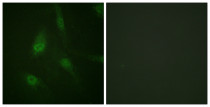ARG66800
anti-NFATc3 phospho (Ser165) antibody
anti-NFATc3 phospho (Ser165) antibody for ICC/IF,Western blot and Human
Overview
| Product Description | Rabbit Polyclonal antibody recognizes NFATc3 phospho (Ser165) |
|---|---|
| Tested Reactivity | Hu |
| Tested Application | ICC/IF, WB |
| Host | Rabbit |
| Clonality | Polyclonal |
| Isotype | IgG |
| Target Name | NFATc3 |
| Antigen Species | Human |
| Immunogen | Phosphospecific peptide around Ser165 (aa. 131-180) of Human NFATc3. |
| Conjugation | Un-conjugated |
| Alternate Names | NFAT4; NFATc3; NFATx; NFATX; NF-ATc3; Nuclear factor of activated T-cells, cytoplasmic 3; T-cell transcription factor NFAT4; NF-AT4 |
Application Instructions
| Application Suggestion |
|
||||||
|---|---|---|---|---|---|---|---|
| Application Note | * The dilutions indicate recommended starting dilutions and the optimal dilutions or concentrations should be determined by the scientist. | ||||||
| Observed Size | ~ 110 kDa |
Properties
| Form | Liquid |
|---|---|
| Purification | Affinity purification with immunogen. |
| Buffer | PBS, 0.02% Sodium azide, 50% Glycerol and 0.5% BSA. |
| Preservative | 0.02% Sodium azide |
| Stabilizer | 50% Glycerol and 0.5% BSA |
| Concentration | 1 mg/ml |
| Storage Instruction | For continuous use, store undiluted antibody at 2-8°C for up to a week. For long-term storage, aliquot and store at -20°C. Storage in frost free freezers is not recommended. Avoid repeated freeze/thaw cycles. Suggest spin the vial prior to opening. The antibody solution should be gently mixed before use. |
| Note | For laboratory research only, not for drug, diagnostic or other use. |
Bioinformation
| Database Links |
Swiss-port # Q12968 Human Nuclear factor of activated T-cells, cytoplasmic 3 |
|---|---|
| Gene Symbol | NFATC3 |
| Gene Full Name | nuclear factor of activated T-cells, cytoplasmic, calcineurin-dependent 3 |
| Background | The product of this gene is a member of the nuclear factors of activated T cells DNA-binding transcription complex. This complex consists of at least two components: a preexisting cytosolic component that translocates to the nucleus upon T cell receptor (TCR) stimulation and an inducible nuclear component. Other members of this family participate to form this complex also. The product of this gene plays a role in the regulation of gene expression in T cells and immature thymocytes. Several transcript variants encoding distinct isoforms have been identified for this gene. [provided by RefSeq, Nov 2010] |
| Function | Acts as a regulator of transcriptional activation. Plays a role in the inducible expression of cytokine genes in T-cells, especially in the induction of the IL-2 (PubMed:18815128). Along with NFATC4, involved in embryonic heart development (By similarity). [UniProt] |
| Cellular Localization | Cytoplasm. Nucleus. Note=Cytoplasmic for the phosphorylated form and nuclear after activation that is controlled by calcineurin-mediated dephosphorylation. Rapid nuclear exit of NFATC is thought to be one mechanism by which cells distinguish between sustained and transient calcium signals. The subcellular localization of NFATC plays a key role in the regulation of gene transcription. [UniProt] |
| Calculated MW | 116 kDa |
| PTM | Phosphorylated by NFATC-kinase; dephosphorylated by calcineurin. [UniProt] |
Images (2) Click the Picture to Zoom In
-
ARG66800 anti-NFATc3 phospho (Ser165) antibody WB image
Western blot: HeLa cells treated with Ca+ 40 nM for 30 min and stained with ARG66800 anti-NFATc3 phospho (Ser165) antibody. The lane on the right is blocked with the phospho peptide.
-
ARG66800 anti-NFATc3 phospho (Ser165) antibody ICC/IF image
Immunofluorescence: HeLa cells stained with ARG66800 anti-NFATc3 phospho (Ser165) antibody. The picture on the right is blocked with the phospho peptide.







